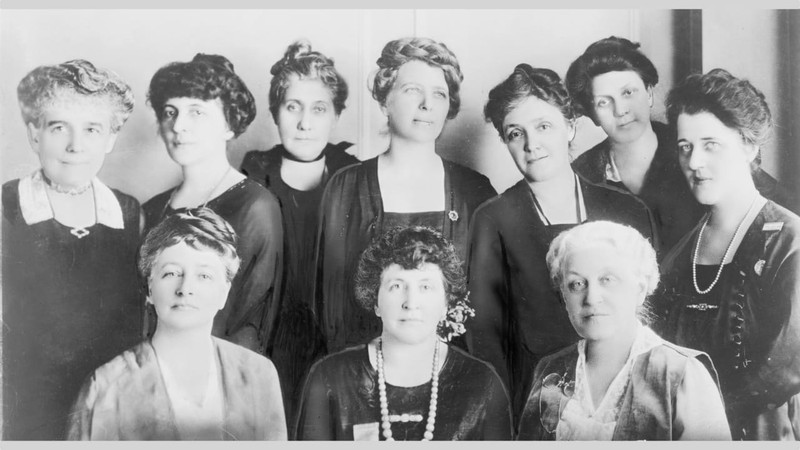The decades of work to win the right to vote for women was only the beginning.

A portrait of the first Board of Directors of the League of Women Voters in Chicago in 1920.
Born Fully Formed
Unlike other service organizations that grew from business lunch groups or afternoon tea circles, the National League of Women Voters (NLWV) was formed as the successor organization of the National American Woman Suffrage Association (NAWSA) to “finish the fight.”
Formed in 1890, NAWSA had been leading the effort to gain the right to vote for decades. Following the shocking aftermath of the World War I, they understood that the right to vote was merely a first step, and that informed voting and the cultivation of democracy itself would be an ongoing task.
The idea for the League was put forward at the NAWSA annual convention in 1919 by Pres. Carrie Chapman Catt, and the organization was formally created the following year on Feb. 14, 1920. Its mission as a political but nonpartisan civic organization was to provide the education and experience necessary to assure the success of democracy. Six months later, the ratification of the 19th Amendment granted the right to vote to 20 million American women.
Having inherited the organization of NAWSA, the League began as a national board and a federated network of state Leagues responsible for organizing the local Leagues. In a few short years, they had organized Leagues in the majority of congressional districts. Conventions were held annually to establish the programs to be undertaken by the League as a whole.
The League was successful in lobbying for issues to be included in the platforms of both political parties and for the passage of legislation advancing their programs. A striking feature of the League organization was the development of their process of “study-member-agreement-action” as a formula for civic engagement.
Making Democracy Work Better
The League worked across all levels of its federated network of chapters. Goals and programs were informed by the study of issues and the observation of defects in governance at the local, state and national level.
Ongoing work included the collection and publishing of candidate questionnaires, the hosting of candidate forums and meetings, voter education, and registration and vote drives.
Following the Great Depression, the League was instrumental in the passage of the most consequential national legislation of the era, including the Social Security Act of 1935, and Federal Food, Drug and Cosmetics Act of 1938, as well as the creation of the Tennessee Valley Authority in 1933.
In 1934, the League began advocating for a merit system to be applied to the hiring of federal employees to administer the programs created under the New Deal. Their efforts helped pave the way for legislation that transformed many of those jobs from the political patronage or spoils system to a professional Civil Service
Protecting and Supporting Democracy Across the Globe
Following World War II, the League was active in building support for the creation of the United Nations, and was one of the first Non Governmental Organizations recognized by the body. The League today holds UN special observer status and is a special consultant to the Economic and Social Council.
The League was also active in support of other global institutions set up in the aftermath of the war including NATO, the World Bank and the International Monetary Fund.
During the Red Scare of the early 1950s. NLWV was active in promoting education about individual rights and civil liberties.
Acknowledging Failures of the Past
The League strongly supported the passage of the Voting Rights Act Amendments of 1982, which extended for another 10 years the enforcement of the “special provisions” in the original Act of 1965 covering certain jurisdictions with a history of racial discrimination. The special provisions included a requirement to apply for “preclearance” before implementing any change affecting voting without first receiving confirmation from the U.S. attorney general or the U.S. District Court for D.C. that the change wouldn't discriminate against protected minorities.
Nevertheless, in a blog post from 2018, the League took responsibility for its part in the betrayal of Black women by the Suffrage Movement and its lack of deep involvement in the Civil Rights movement in the 1950s and 1960s.
The Modern League of Women Voters
The 1990s saw the League adopting positions on gun control and health care, and successfully lobbying for the reauthorization of the Clean Air Act and passage of the National Voter Registration Act.
Following a multi-year brainstorming effort in the early 1990s, the League celebrated its 75th anniversary in 1995 refocused and reinvigorated.
Now more than 100 years old, the League of Women Voters continues its work to advance good democracy and good governance. Though it has had a profound impact on the shaping of national and international institutions, it still works quietly at the most local level, educating voters about candidates running for office and the issues on the ballot in every election, as it has since 1920.
There are chapters in most counties in California who would welcome your participation in this important and ongoing project.
Learn more about the League of Women Voters
Long form articles which explain how something works, or provide context or background information about a current issue or topic.